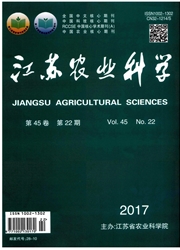

 中文摘要:
中文摘要:
[目的]探讨不同程度水分胁迫下桂花幼苗的生理生化响应。[方法]以2年生桂花幼苗为试验材料,采用盆栽方式,设计田间持水量的10%(A1)、25%(A2)、40%(A3)、55%(A4)、70%(A5,CK)5种不同的水分胁迫条件,研究不同水分条件下桂花幼苗的生理响应。[结果]结果表明,水分胁迫抑制桂花幼苗的生长,随水分胁迫程度增加,根冠比增大;桂花叶片SOD和POD的活性呈现出"升高-降低"的模式,A1处理保护酶的升高和下降表现最为显著;桂花幼苗叶片MDA含量随着水分胁迫程度的增大和时间的延长而增加。[结论]研究结果为桂花的水分管理和抗逆性栽培提供了理论依据。
 英文摘要:
英文摘要:
t [Objective]The aim was to explore physiological and biochemical responses of Osmanthus fragrans Lour. seedlings under different water stresses. [Method] A pot experiment was conducted to study the physiological responses of 2-yeas-old Osmanthus fragrans Lout. seedlings to water stress. Five treatments were installed, i. e., A1(10% of field capacity ), A2(25% of field capacity), A3(40% of field capacity ), A4 (55% of field capacity) water stress and control (As, CK,70% of field capacity). [Result]With increasing water stress, the root- shoot ratio accreted. SOD and POD activity of Osmanthus fragrans Lour .leaf promoted firstly and then reduced. Protective enzyme of At changed significantly. And MDA content raised with the increase of water stress and the extension of time. [Conclusion] The result provided a theoretical basis for water management and resistance cultivation of Osmanthusfragrans Lour..
 同期刊论文项目
同期刊论文项目
 同项目期刊论文
同项目期刊论文
 期刊信息
期刊信息
